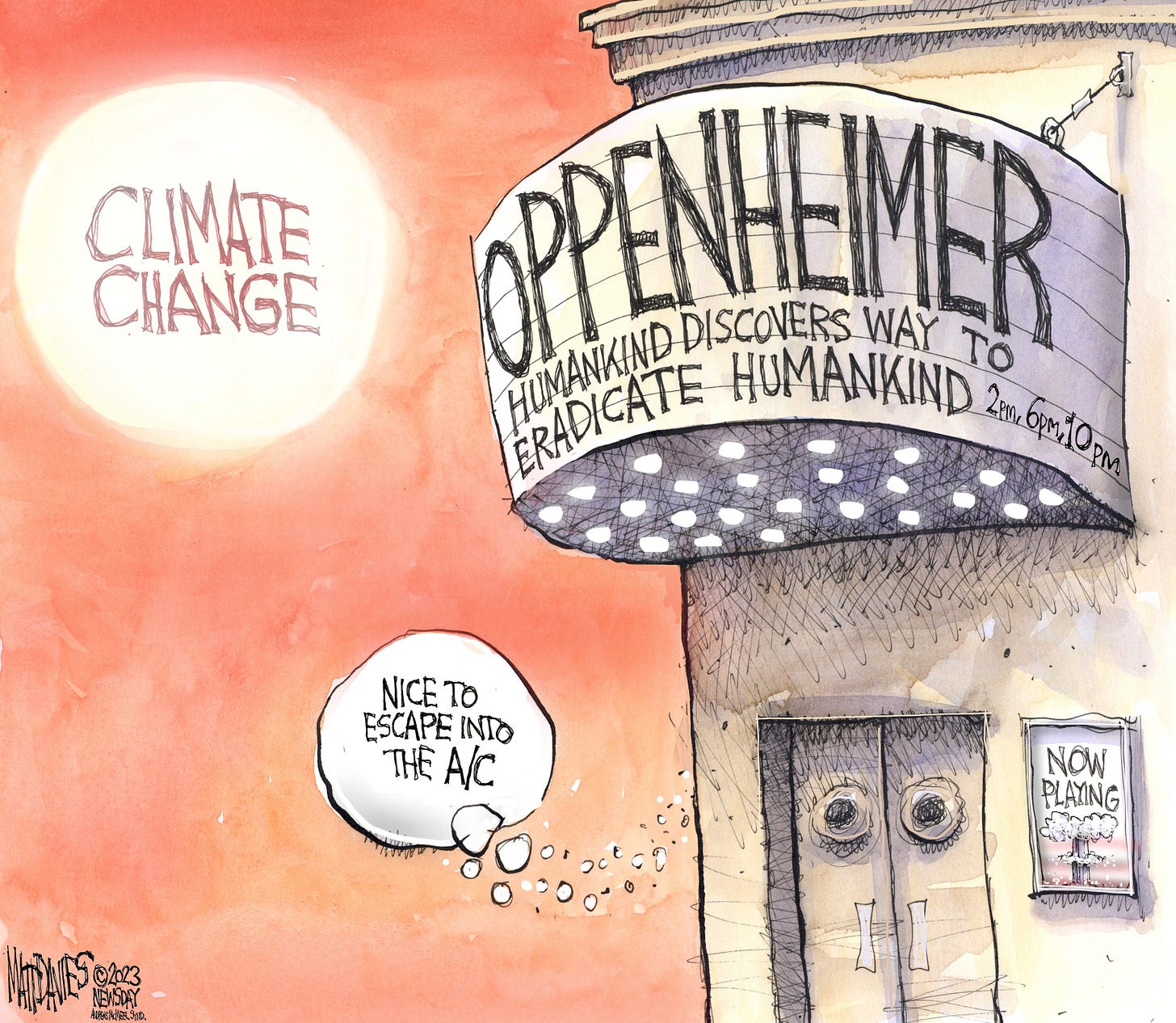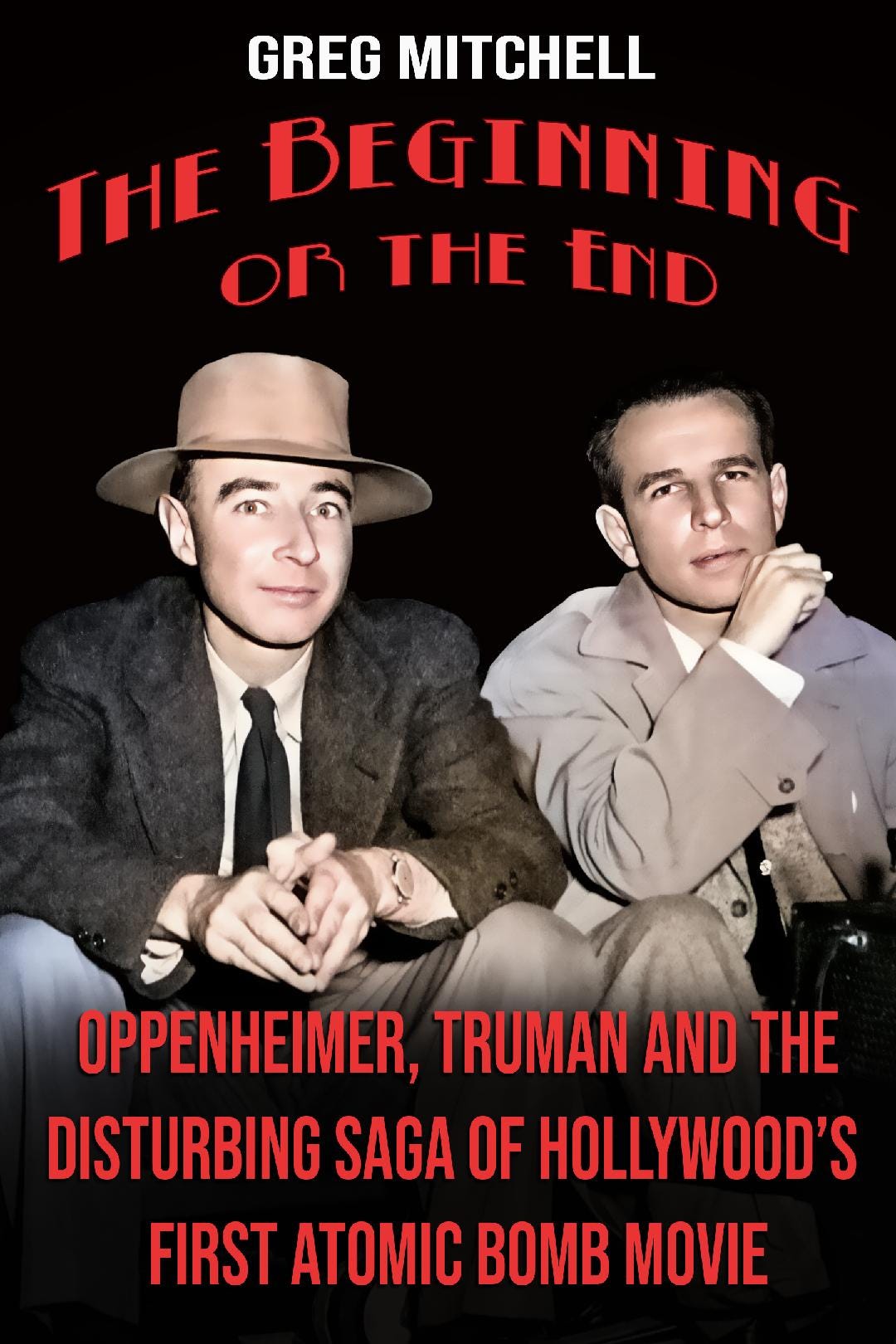What We Didn't See in 'Oppenheimer'
Nearly identical scene with crucial images (from 1979), plus Bob Dylan on the Bomb, and more....
Strong response to this new bloggy newsletter and my various articles and media appearances in past week or so has been gratifying, especially since it has drawn attention to key issues surrounding nuclear dangers that I have been raising since, oh, 1982. Among other things, there’s been a run on my book “Atomic Cover-up,” whose story really launched my nuclear obsession that year. I also enjoyed Will Bunch at the Philadelphia Inquirer hailing me as “pioneering rock journalist.” Now that is another story…
I’m also getting Oppenheimer-related “tips,” including this one (although I had to dig up the footage) from BookLockdown over at the Site Formerly Known as Twitter. I complained here yesterday, and in previous posts and an article, that while Christopher Nolan briefly shows Oppenheimer in a screening room watching film from post-bomb Hiroshima, he only covers his facial reaction, not the footage. Not even a glimpse. It’s a criticial ommision in the movie; Nolan could have shot it a number of ways that would have been powerful and not overwhelmingly graphic.
Well, an almost exact scene, and with the same side camera angle on Oppie, was included long ago in the first TV series on the physicist, from the BBC and PBS in 1979, Oppenheimer, starring Sam Waterston. There, Oppie and others (including Gen. Groves) watch in silence as images from Hiroshima unspool on the screen, but in that case we do see some of the victims: grainy, and no dead bodies, but at least one may get the idea that, as in real life, the vast majority were women and kids. Here is part of the scene, which includes' Groves’ response.
More items below. And yes, you can still subscribe, it’s free.
Yesterday, I observed the anniversary this week of our second atomic test in the Pacific. But what about the first one? That came earlier in July, in the Bikini Atoll, following the forced removal of all 167 of its tribal residents. Robert Oppenheimer had decided not to play the role of distinguished eyewitness. He had seen more than enough at Trinity.
That first Hiroshima-sized bomb at Bikini was set off above a fleet of antiquated ships, testing its power at sea, on July 1. This was not without controversy. Few in the media cared what happened to the Bikinian natives, but some worried the blast might ignite the atmosphere, trigger tidal waves, or create a fissure in the earth’s crust. Newspapers carried witty accounts of Los Angeles residents planning to enjoy picnics high in the hills on the day of the blast instead of by the beach in case a tsunami rose from the ocean.
Oppenheimer had explained in a message to Truman that he had severe “misgivings” about the tests, which were shared by many other scientists. If the purpose of the test was to judge how vessels might survive—well, no such blast was needed: “If an atomic bomb comes close enough to a ship . . . it will sink it.” For just one percent of the projected $100 million cost for the tests “one could obtain more useful information.” As for the radiation studies: they, too, could be obtained more accurately and cheaply in a lab. And why a “trivial” test at sea? Everyone knew the purpose of the new weapon (as the world had already been shown, by Truman himself) “lies in their use for the bombardment of cities.” Most importantly, Oppenheimer questioned “the appropriateness of a purely military test of atomic weapons, at a time when our plans for effectively eliminating them from national armaments are in their earliest beginnings.”
Truman was not swayed. He forwarded the letter to Acting Secretary of State Acheson, reminding him that this was the same “crybaby scientist” who claimed he had blood on his hands when they met in the Oval Office the previous October (as shown in Nolan’s movie). “I think he has concocted himself an alibi in this letter,” Truman decided.
Film on the test and tragedy of the offloaded islanders:
Every year at this time over at my Pressing Issues blog, I publish a Countdown to Hiroshima, a look at what happened each day in 1945 leading up to the atomic attack. Today’s entry is fairly noteworthy, adapted below:
—Early on July 26, Chief of Staff Gen. George Marshall cabled to Gen. Leslie Groves back in Washington, DC, his approval of a directive sent by Groves the night before. It read: “1. The 509th Composite Group, Twentieth Air Force, will deliver its first special bomb as soon as weather will permit visual bombing after about 3 August 1945 on one of the targets: Hiroshima, Kokura, Nigata and Nagasaki…. 2. Additional bombs will be delivered on the above targets as soon as made ready by the project staff…..”
This unthinking, assembly-line approach would have tragic consequences for the city of Nagasaki.
Oddly, in a 1946 letter to former Secretary of War Henry Stimson, who was preparing his soon-to-be influential cover story in Harper’s defending the decision to drop the bomb, Truman reminded him that he had ordered the bombs used against cities engaged “exclusively” in war work. Truman would later write in his memoirs, “With this order the the wheels were set in motion for the first use of an atomic weapon against a military target.” Even years after the decision, and all the evidence (largely kept from the American people) that Hiroshima and Nagasaki were only partly “military” targets, and 170,000 or more civilians perished, Truman still acted otherwise.
--The other major event from this day was equally significant. The Potsdam Declaration was issued in Germany by the United States, Britain and China. The Soviet Union was still not at war with Japan but agreed to enter the conflict by mid-August 8. (This has led some to suggest that we used the bombs quickly to try to end the war before the Russians could claim much new territory.) It was Truman’s first key wartime conference with other top leaders.
The declaration ordered Japan to surrender immediately and unconditionally or face a reign of ruin—“prompt and utter destruction”—although the new weapon was not mentioned (such a warning had been considered by Truman but rejected). Much was made of the importance of the “unconditional” aspect but three weeks later, after the use of the new bombs, we accepted a major condition, allowing the Japanese to keep their emperor--and still called the surrender “unconditional.”
Some historians believe that if we had agreed to that condition earlier, Japan might have started the surrender process after the Soviets entered the war and before the use of the atomic bombs. Others believe an explicit warning to the Japanese, or a demonstration of the new weapon offshore in Japan, would have speeded the surrender process. But the Potsdam Declaration set US policy in stone.
I’ve been a major Bob Dylan fan going back, ouch, 60 years now. His early bomb-soaked songs such as “Hard Rain” and “Talking World War 3 Blues” no doubt had some impact on my view of nuclear dangers, then and later. So it was interesting to come upon his comments in a Rolling Stone interview.
Dylan: For some reason, the 1950s and 1960s interest people now. A part of the reason, if not the whole reason, is the atom bomb. The atom bomb fueled the entire world that came after it. It showed that indiscriminate killing and indiscriminate homicide on a mass level was possible . . . whereas if you look at warfare up until that point, you had to see somebody to shoot them or maim them, you had to look at them. You don’t have to do that anymore.
With the atom bomb, man – suddenly, and for the first time – had the power to utterly destroy mankind.
I think so. I’m sure that fueled all aspects of society. I know it gave rise to the music we were playing. If you look at all these early performers, they were atom-bomb-fueled. Jerry Lee, Carl Perkins, Buddy Holly, Elvis, Gene Vincent, Eddie Cochran . . .
How were they atom-bomb-fueled?
They were fast and furious, their songs were all on the edge. Music was never like that before, Lyrically, you had the blues singers, but Ma Rainey wasn’t singing about the stuff that Carl Perkins and Jerry Lee were singing about, nobody was singing with that type of fire and destruction. They paid a heavy price for that, because obviously the older generation took notice and kind of got rid of them as quickly as they could recognize them. Jerry Lee got ostracized, Chuck Berry went to jail, Elvis, of course, we know what happened to him. Buddy Holly in a plane crash, Little Richard, all that stuff . . .
Dylan’s first performance on TV of “Hard Rain” in 1963, below about the time I discovered him….And here you can listen as they performs “Masters of War” in….Hiroshima.






Wowza, but we have so much in common! I still want to duck n cover when the freakin grocery checkout blaps at me to "remove your card".
This movie is WAY too important not to share NOW. Humanity must change its understanding of nuclear weapons or perish.
Don't make the same mistake Michael Moore made with Fahrenheit 9/11, which was out in plenty of time to stop Bush from winning a second term. But he made it too hard to watch: expensive DVD or go to a theater and spend a fortune. It was funny and the facts were tight and presented in the most compelling way. But Bush won and America was broken forever.
I wish I had a link to share this movie with my million readers on Quora. Why not Amazon for $3.99? NOW?